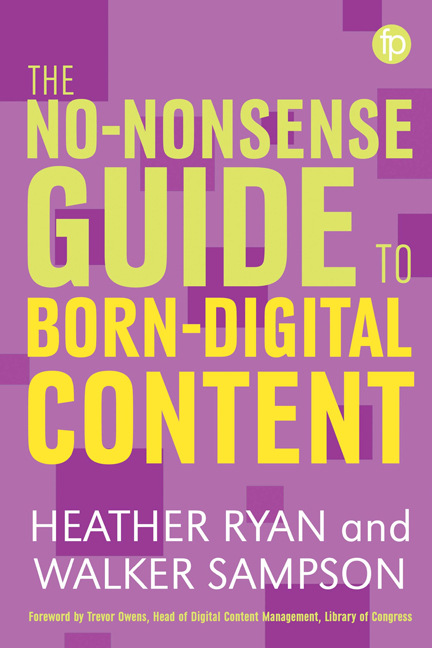Book contents
- Frontmatter
- Contents
- List of figures and tables
- Foreword
- Acknowledgements
- List of abbreviations
- Glossary
- Introduction
- 1 Digital information basics
- 2 Selection
- 3 Acquisition, accessioning and ingest
- 4 Description
- 5 Digital preservation storage and strategies
- 6 Access
- 7 Designing and implementing workflows
- 8 New and emerging areas in born-digital materials
- Conclusion
- References
- Appendix A Resources
- Appendix B Basic Unix command line prompts
- Index
Introduction
Published online by Cambridge University Press: 08 June 2018
- Frontmatter
- Contents
- List of figures and tables
- Foreword
- Acknowledgements
- List of abbreviations
- Glossary
- Introduction
- 1 Digital information basics
- 2 Selection
- 3 Acquisition, accessioning and ingest
- 4 Description
- 5 Digital preservation storage and strategies
- 6 Access
- 7 Designing and implementing workflows
- 8 New and emerging areas in born-digital materials
- Conclusion
- References
- Appendix A Resources
- Appendix B Basic Unix command line prompts
- Index
Summary
For tens of millennia humankind has made purposeful, material marks on whatever surface was available. Human beings have recorded evidence of their existence with ground rock smeared on cave walls, carvings in stone, plant fluids brushed onto papyrus, gold and coloured inks painted on animal skin, dark inks rolled onto movable type and pressed into paper, and magnetised iron oxide on a plastic substrate disk. These artefacts, whether they can be read ten minutes or ten millennia from now are all evidence of humans attempting the often Herculean feat of making sense of the world around them. No matter the medium, we are fixing our ideas and creations into a form that will allow them to move into the future. Over time, the content has been relatively similar, but the quantity and methods of recording this content have changed drastically.
In our current age, nearly all data and creative outputs are generated, stored and accessed through the use of computers. Records of our transactions, of our communication and experiences with one another, of our thoughts, ideas and creative outputs are almost all created, stored and transmitted via digital encoding. How much of your own communication and work is transacted or recorded digitally? More importantly for the library and archival professions, how do we go about collecting, preserving and providing access to it? This question may seem difficult or daunting to answer, but we can make it simple for you by starting with the basics and building from there.
What is born-digital content?
Photographs, books and maps created and printed on paper-based mediums can be ‘digitised’. For the past few decades digitised content has been in high demand and a game-changer for libraries and archives’ ability to share their resources across the globe. Digitising valuable and fragile materials reduces handling and therefore helps preserve the originals for longer periods of time.
Recently, however, more attention has been directed toward the content that is being created, distributed and used solely in digital form. This content is called ‘born digital’ because it was created or ‘born’ digitally, and in most cases is not transferred or accessed otherwise. Because there is no original paper-based or analogue version of born-digital content, it poses some unique challenges in preserving access to it over the long term.
- Type
- Chapter
- Information
- The No-nonsense Guide to Born-digital Content , pp. 1 - 8Publisher: FacetPrint publication year: 2018



